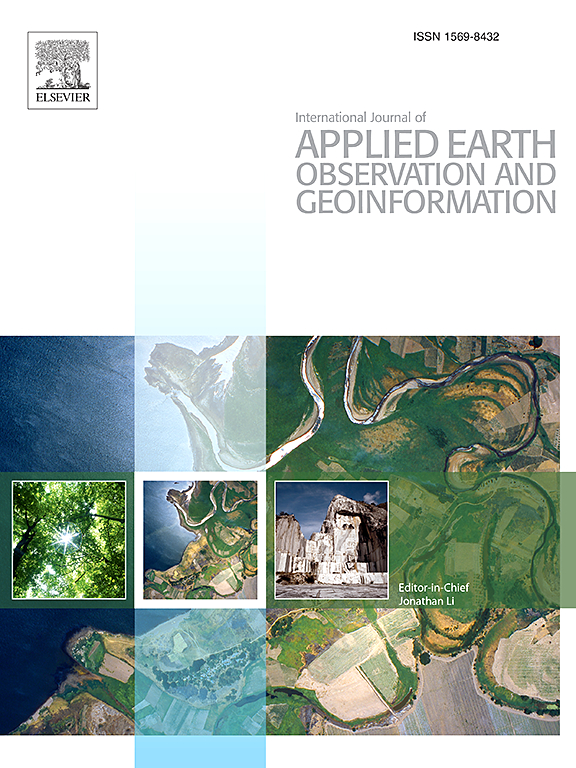IF 7.6
Q1 REMOTE SENSING
International journal of applied earth observation and geoinformation : ITC journal
Pub Date : 2025-02-01
DOI:10.1016/j.jag.2025.104371
引用次数: 0
摘要
冰川湖泊是气候变化的重要指标,可以让人们深入了解冰川动力学、质量平衡和海平面上升。然而,由于小湖泊的检测、阴影干扰和复杂的地形条件,精确制图仍具有挑战性。本研究介绍了 U-ViT 模型,这是一个利用 IBM-NASA Prithvi Geo-Foundation Model (GFM) 解决这些问题的新型深度学习框架。U-ViT 采用 U 型编码器-解码器架构,具有增强型多通道数据融合和全局-局部特征提取功能。它集成了一个增强型挤压激励块,可在各种输入维度上进行灵活的微调,并结合了反向瓶颈块来改进局部特征表示。该模型在两个数据集上进行了训练:北巴基斯坦(NPK)的哨兵-1&2 融合数据集和西格陵兰(WGL)的高分-3合成孔径雷达数据集。实验结果凸显了 U-ViT 模型的有效性,在 NPK 数据集上的 F1 得分为 0.894,明显优于得分低于 0.8 的基于 CNN 的传统模型。与公开数据集相比,该模型在检测小型湖泊、精确分割边界和处理云影特征方面表现出色。值得注意的是,U-ViT 在训练数据减少 50% 的情况下仍能表现出强劲的性能,这凸显了它在数据稀缺的任务中进行高效学习的潜力。不过,U-ViT 在 WGL 数据集上的表现并没有超过 DeepLabV3+,这揭示了预训练和输入数据模式之间的差异所带来的局限性。支持这项研究的代码可在线获取。这项研究为通过应用全球冰川地貌模型推进大规模冰川湖泊测绘奠定了基础。本文章由计算机程序翻译,如有差异,请以英文原文为准。
Glacial lake mapping using remote sensing Geo-Foundation Model
Glacial lakes are vital indicators of climate change, offering insights into glacier dynamics, mass balance, and sea-level rise. However, accurate mapping remains challenging due to the detection of small lakes, shadow interference, and complex terrain conditions. This study introduces the U-ViT model, a novel deep learning framework leveraging the IBM-NASA Prithvi Geo-Foundation Model (GFM) to address these issues. U-ViT employs a U-shaped encoder–decoder architecture featuring enhanced multi-channel data fusion and global-local feature extraction. It integrates an Enhanced Squeeze-Excitation block for flexible fine-tuning across various input dimensions and combines Inverted Bottleneck Blocks to improve local feature representation. The model was trained on two datasets: a Sentinel-1&2 fusion dataset from North Pakistan (NPK) and a Gaofen-3 SAR dataset from West Greenland (WGL). Experimental results highlight the U-ViT model’s effectiveness, achieving an F1 score of 0.894 on the NPK dataset, significantly outperforming traditional CNN-based models with scores below 0.8. It excelled in detecting small lakes, segmenting boundaries precisely, and handling cloud-shadowed features compared to public datasets. Notably, the U-ViT demonstrated robust performance with a 50% reduction in training data, underscoring its potential for efficient learning in data-scarce tasks. However, its performance on the WGL dataset did not surpass that of DeepLabV3+, revealing limitations stemming from differences between pre-training and input data modalities. The code supporting this study is available online. This research sets the stage for advancing large-scale glacial lake mapping through the application of GFMs.
求助全文
通过发布文献求助,成功后即可免费获取论文全文。
去求助
来源期刊

International journal of applied earth observation and geoinformation : ITC journal
Global and Planetary Change, Management, Monitoring, Policy and Law, Earth-Surface Processes, Computers in Earth Sciences
CiteScore
12.00
自引率
0.00%
发文量
0
审稿时长
77 days
期刊介绍:
The International Journal of Applied Earth Observation and Geoinformation publishes original papers that utilize earth observation data for natural resource and environmental inventory and management. These data primarily originate from remote sensing platforms, including satellites and aircraft, supplemented by surface and subsurface measurements. Addressing natural resources such as forests, agricultural land, soils, and water, as well as environmental concerns like biodiversity, land degradation, and hazards, the journal explores conceptual and data-driven approaches. It covers geoinformation themes like capturing, databasing, visualization, interpretation, data quality, and spatial uncertainty.
 求助内容:
求助内容: 应助结果提醒方式:
应助结果提醒方式:


